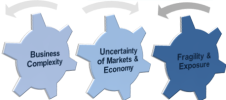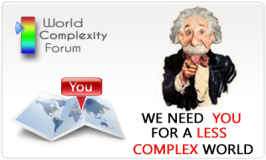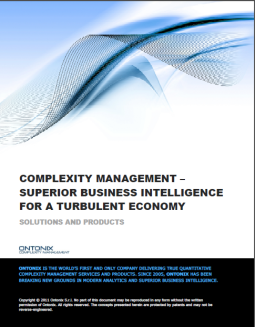Innovation: listen to Confucius…and look within
Sunday, 15 May, 2011 Leave a comment
“To put the world right in order, we must first put the nation in order; to put the nation in order, we must first put the family in order; to put the family in order, we must first cultivate our personal life; we must first set our hearts right.”Confucius
 I thought it worth sharing this extract from a recent email exchange. Because, it is true to say that, grasping the nature of what we (Ontonix) do can be difficult PARTICULARLY when it is perceived as a “challenge” to long (and dearly-held) belief systems. Even though the knowledge and technology upon which they are based have been discredited or superseded!:
I thought it worth sharing this extract from a recent email exchange. Because, it is true to say that, grasping the nature of what we (Ontonix) do can be difficult PARTICULARLY when it is perceived as a “challenge” to long (and dearly-held) belief systems. Even though the knowledge and technology upon which they are based have been discredited or superseded!:
We identify what is otherwise deemed to sit within the domain of “partially reducible uncertainty” and bring it into the domain of “fully reducible uncertainty”. By measuring data at micro level we have established that the complexity and robustness of dynamic, non-linear, systems, “register” what, otherwise, appear to be sudden and unforeseen mode-changes, “phase transitions” or shifts from an, apparently, stable (equilibrium) system state. It is universally true of dynamic systems: think seismic activity from multiple monitors as the pre-cursor to earthquakes. Hence the numerous applications of our technology, including real-time monitoring for “high dependency” health care, critical manufacturing or energy processes, IT systems, Air Traffic control, etc. Crisis anticipation for the system owner or observer and the ability to identify and address, such as, operational or process weaknesses within a system.
No altering or discounting system data! 100% objective and quantitative. The scope of the data defines the “boundary” of what can be measured and more data means greater granularity and a more detailed map of structure of the system.
Currently, particularly in financial sector, we have become used to viewing systems at macro level and rely upon “sampling data” according to Accounting convention or Regulatory requirement. But, as we now know, these metrics can be manipulated to provide a false impression and tell us little about the actual “health” of the system. They are merely benchmarks against past performance or that of other within the sector or marketplace.Like taking a blood sample and performing tests to establish or discount what symptoms and intuition suggest to be the cause of ill-health: you won’t find what you don’t look for!
This is precisely why our technology breaks new ground because, for the first time, it enables system owners and observers to determine the health of the system being measured and to drill-down to establish causality.
I sincerely hope that this adds greater clarity about what we do!? If so it will, probably, explain my frustration with this long-running discussion that, every-so-often, gets close to the view required to tackle some of the most pressing issues…and if you scale-up the thinking to turn the threat of systemic risk, through financial inter-connections, into financial resilience”.
What we have now is a new solution to be applied as a genuine platform for innovation so that it can:
-
increase profitability
-
reduce risk exposure
-
improve the ability to withstand the unforeseeable events
-
gain competitive advantage
THE QUESTION: If huge benefits are attainable – by identifying internal structural/operational weaknesses (i2o) and extending the risk horizon into a company’s ecosystem – at what point does the failure to do so and to manage these matters become a Corporate Governance issue?











